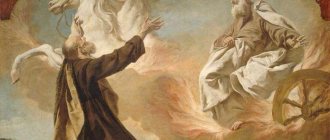Human life on earth is subject to laws (state, moral and spiritual), which are passed on from one generation to another. Elders give younger descendants or followers instructions, advice or orders that help them not make mistakes and walk the path of life with dignity. In theological and religious usage the word “covenant” is used - this is a sacred vow or agreement between God and man.
In Christianity and Judaism, the main spiritual instructions are contained in the Bible, which consists of two parts - the Old and New Testaments. The two sections of the holy book combine a series of historical events, starting from the creation of the world by the Lord and ending with the spread of Christianity throughout the earth by the apostles (messengers) of Jesus Christ, the son of God.
The Holy Bible: Structure and Contents
The Old Testament and the New Testament, the differences and similarities of which we will consider further, are two sections of the Christian Holy Scripture - the Bible. Both Testaments are God's Revelation for man. They were created by righteous people with the participation of the Holy Spirit. Thus, the Bible is the fruit of the co-creation of God and man. Therefore, the text of Scripture is inspired by God, but has the characteristic features of the style of its earthly authors.
Bible
The canonical (that is, recognized by the Orthodox Church as inspired) composition of the Bible includes 66 books. Most of them (39) refer to the Old Testament. These works were written by the prophets of Ancient Israel between the 13th and 4th centuries BC. The original language of these texts is Hebrew. The remaining 27 books of the Bible make up the New Testament. They were created after the birth of Christ by His disciples (apostles), during the 1st century AD. When writing these works, colloquial ancient Greek was used.
All Holy Scripture reflects the story of the salvation of fallen man from the power of sin and death. This happened thanks to the incarnation (incarnation) of God. At the same time, the Old Testament speaks of salvation through prophecies and types. Thus, he prepares a person (so far only within the chosen Israeli people) for the Incarnation. The New Testament tells about the coming of the Savior Jesus Christ to our world. His Nativity, earthly life, teaching, mission, Resurrection and Ascension - this is described in the second part of the Bible.
The meaning of the covenant in different religions
In every religion this concept has its own meaning.
In Christianity
In Christianity it has the following meanings:
- Christian scripture that arose after the birth of Jesus Christ.
- A term that denotes a new qualitative relationship between God and man.
- The main commandments of Christianity.
In Judaism
In Judaism, the concept has a large number of meanings:
- One of the schools of Calvinist thought that views all history as a series of covenants between God and people.
- The Seven Commandments, which according to Judaism are necessary for humanity.
- 10 commandments of Moses.
- Circumcision is a surgical operation that removes the foreskin from boys and men, as a sacrificial offering of a part of one’s body to the Lord.
In other religions
In other religions it has several meanings:
- In the Baha'i religion, an agreement that is concluded by a believer at the moment he accepts a particular religion.
- Concepts of many authors who strive to create a modern new worldview.
- The Abrahamic contract in Mormonism is the contract of exaltation that was made between God and Abraham at the time of Abraham's celestial marriage.
Celestial marriage is a major part of preparation for eternal life. It requires entering into a marriage partnership with the right person in the right place, and faithfully keeping that sacred covenant.
There is no concept of covenant in Islam. The Koran does not say anything about the agreement that Allah would enter into with Muslims. Allah sends down to the prophets and messengers each his own text. The messenger's task is to convey a text, which, in essence, is instructions for correct behavior. This is a mandate, or even an order. Muslims did not accept either Christian or Jewish scriptures.
What is a Covenant?
In Christianity, the term “covenant” means an agreement, a union between the Creator and humanity, established for the salvation of the latter. By adhering to the covenant, a person maintains a saving connection with the Almighty. Violation of the union leads to the spiritual destruction of God's main creation. Several such agreements were established in pre-Christian times. The Old Testament is their common unifying name.
The first union with God was established by Adam and Eve in paradise. The Almighty blessed our first parents:
“Be fruitful and multiply, and fill the earth and subdue it” (Gen. 1:28).
The only prohibition was access to the fruits of the tree of paradise of the knowledge of good and evil. At the instigation of the devil, the inhabitants of paradise disobeyed the Creator, ate the fruits of the mysterious tree, breaking the covenant.
The fall of Adam and Eve deprived humanity of a grace-filled connection with God. Evil has poisoned our existence, bringing suffering and death into it. In the “Message of the Patriarchs of the Eastern Catholic Church on the Orthodox Faith” of 1723, the following words can be found:
“We believe that the first man fell in paradise and that from here the ancestral sin spread successively to all posterity, so that there is not a single one born according to the flesh who is free from that burden and does not feel the consequences of the fall in this life. And we call the burden and consequence of the fall <...> the inclination to sin and those disasters with which Divine justice punished a person for his disobedience, such as: exhausting labor, sorrow, bodily infirmities, birth illnesses, difficult life on earth for some time, wanderings , and finally, bodily death.”
The concepts of “Old Testament” and “New Testament”: difference
Participants in the remaining pre-Christian unions with God were the chosen people of Israel. These covenants were made through the prophets. Among them, for example, the successor of the human race, Noah, who was saved from the Flood, the ancestor of many nations, Abraham, and Moses, who led the Jews out of Egyptian slavery. The Old Testaments could not restore the former connection with the Creator, but gradually prepared the possibility of its restoration.
The Old Testament Divine laws and regulations placed man in a subordinate position before the Almighty. However, this was necessary to curb our lost, cruel and depraved nature. To understand the lofty Gospel teaching, a person first had to learn basic moral standards, renounce paganism, and come to know the One God. This was the meaning of the Old Testaments. In the words of Archpriest Seraphim Slobodsky, only by fulfilling the “law of strict truth” were people able to move on to Christ’s “law of Divine love and grace.”
The coming of Christ and His Atonement for our sins reconciled man with God, establishing a relationship between them on a completely different level - the New Testament. How is the Old Testament different from the New Testament? The latter is no longer concluded temporarily and not with a separate people. And forever and with all humanity, opening the way for each of us to the once lost paradise. To become a participant in the New Testament and gain Eternal Life, you must believe in Christ, accept Holy Baptism and work hard to fulfill the New Testament commandments. Regular participation in the Church Sacraments helps with this. For example, in the Eucharist (Communion) established by the Lord, we can unite with Him and sanctify our nature. Saint Ignatius Brianchaninov teaches:
“He only can inherit eternal bliss who has previously dissolved communion with sin, who has previously entered into holy communion with God” (Complete Collection of Creations, volume 1).
Books of the Old and New Testaments
The books that make up the Old Testament and the New Testament are divided according to their content into legal, teaching, historical and prophetic. The law-positive texts of the Old Testament include its first five books (the Pentateuch of Moses): Genesis, Exodus, Leviticus, Numbers, Deuteronomy. These works describe the creation of the Universe and man, the fall of Adam and Eve, the lives of their descendants, as well as the laws (commandments) that God gave to the Jewish people through the prophets.
The 4 Gospels (Mark, Matthew, Luke, John) are considered the New Testament books of law. They contain stories about the earthly ministry of the Lord, as well as His teachings.
Historical are 12 Old Testament books about the chronicles of the Jewish people before the coming of the Messiah (the books of Joshua, Tobit, Esther, etc.), as well as the New Testament Acts of the Holy Apostles about the missionary work of Christ’s disciples after His Ascension. Using the example of the fate of one people, Old Testament texts show us the salvific nature of God's Providence, the consequences of deviation from the Covenant and the meaning of repentance. These historical books teach that only those who make efforts to do so can be saved. Thanks to the New Testament chronicle of the apostolic acts, we can learn the history of the origin and development of the Christian Church.
A covenant is an agreement between two or more parties
And fulfill the terms they agreed to. If we talk about the blood covenant, then it can only be dissolved by death. The blood covenant is the strongest covenant known to man.
When an agreement is made - a covenant with God, He will never break His part.
There is a covenant of grace—a covenant of unmerited favor.
There have been different covenants throughout history. For example, the covenant of Adam. This is the covenant that God made with Adam. There was also a covenant with Noah. There was a covenant with Abraham. These are just a few of the covenants.
There are two main covenants that we should know about and that concern us today:
- Old Testament of Moses.
- New Testament of Jesus Christ.
If you have an understanding of the difference, then you will have unshakable faith and confidence in God's unmerited favor.
Teaching and prophetic books of the Bible
The teaching books include 5 Old Testament books about wisdom and righteousness (Psalms, Proverbs of Solomon, etc.), as well as 21 New Testament letters of the apostles (Paul, James, etc.). These messages are letters of instruction for Christians in general or for their specific communities.
The remaining biblical books are prophetic. First of all, these are 17 Old Testament works named after prophetic authors (Isaiah, Ezekiel, Jeremiah, etc.) with predictions about the Jewish people and the coming of the Savior. Prophetic texts guide the chosen people on the path of salvation and remind them of the importance of following Divine instructions. According to Archpriest Gennady Fast, messianic prophecies are “the essence and core of the entire Old Testament.”
The only New Testament prophetic book is the Revelation of the Lord about the end of times, recorded by the Apostle John the Theologian. This text touches on such events as the Second Coming of Christ, the Last Judgment, the final victory of God over evil and the establishment of the Kingdom of Heaven.
So, after analyzing both Testaments, we can come to the conclusion about their fundamental substantive difference. The first part of Scripture emphasizes laws, rituals, history, and prophecies. The second section of the Bible focuses on the themes of moral perfection, unity with God and the prospect of Eternal Life. Archpriest Oleg Stenyaev notes:
“The Old Testament talks about what man had to do for God. The New Testament talks about what God did for man. Of course, these are incommensurable things. Therefore, St. John Chrysostom says that the New Testament is higher than the Old, just as heaven is higher than the earth.”
How to spell it correctly?
In the Russian language there is both the word “calling” and the word “testament”.
The choice between the vowel “a” and “o” depends on what part of speech it is. It is not difficult to determine this; it is enough to ask a question about the word based on the context. The noun will answer the questions: “who?”, “what?”, the verb will answer the questions “what to do?”, “what to do?”, “what does it do?”, “what will it do?”, “what did it do?”.
The difference between the words “calls” and “covenant” is also that the stress in the verb is the vowel “е”, and in the noun – “e”. This is an additional difference that will allow you to differentiate words from each other and prevent mistakes in their spelling.
The Meaning of the Old and New Testaments
The Old and New Testaments - the difference between them is obvious. However, the Orthodox Church views them as a single saving Revelation of a loving Creator. Archpriest Vsevolod Chaplin notes:
“In the Holy Scriptures of the Old and New Testaments, the True God revealed himself in full.”
As St. Ephraim the Syrian taught, both Testaments are “a single body of Truth.” The Lord Himself emphasized that He does not abolish the Law, but complements and develops it (Matthew 5:17). The Old Testament is the foundation for the New. It is a “schoolmaster to Christ” (Gal. 3:24) who enabled fallen man to “grow” to the heights of the Gospel.
Without knowledge of the first part of the Holy Scriptures, a full understanding of the New Testament is impossible. How did humanity lose paradise and why did it wait so long for the Savior? The Old Testament answers these questions. Let us quote the words of Priest Evgeny Murzin:
“If we discard the Old Testament, then we will understand practically nothing in the Gospel. The Old Testament is full of prophecies and types, the fulfillment of which we see in the earthly life, death and resurrection of the Savior.”
If the Old Testament, in the words of St. Ignatius (Brianchaninov), is a “transformation of salvation,” then the New Testament “more abundantly teaches” this salvation (Complete Collection of Creations, volume 4). The second part of the Bible is a precious source of Christ's teaching. This is an instruction on how to restore the connection with the Creator broken by the Fall. How to not only cleanse your soul from sin, but also fill it with Divine grace. Priest Andrei Chizhenko notes:
“The Holy Gospel is the main book of humanity, which contains life for people. It contains Divine truths that lead us to salvation. And it itself is the source of life - a word truly filled with the power and wisdom of the Lord. This is the voice of Christ himself.”
The significance of both Testaments in Orthodoxy is confirmed by the presence of their texts in Christian services. For example, none of them is complete without quoting the Old Testament psalms of David, reflecting the multifaceted relationship between man and God. Six psalms are read at once at Matins (Six Psalms). The Gospel chapters are solemnly recited at Matins, All-Night Vigil, Divine Liturgy, prayer services, and in some Sacraments and services. At the liturgy, before the Gospel, the Apostolic Epistles and Acts are also read.
In what cases do they write “calling”
The word “calls” is written if it is a verb. You can make sure that the vowel “o” is written in the root by choosing the cognate noun “call”.
Also, do not forget that the vowel letter “e” is written under the stress in this word.
Example sentences
- My cousin is inviting me to a wedding, but I don't want to go.
- If he asks you out for the fifth time in a row, I think you should say yes.
- My son has been calling his puppy by his name for a month now, and he has already begun to respond.
- He often invites me to go for a walk to this park.
- I don't like that he always invites his friend to go out with us.
Prayers before and after reading the Gospel
Brief prayer before reading the Gospel
Lord Jesus Christ! Open the eyes of my heart, so that I may hear Your word and understand it and do Your will.
The prayer is different
Shine in our hearts, O Lord, the love of mankind, of Your knowledge of God, the imperishable light, and open our mental eyes to the understanding of Your gospel sermons, invest in us and Your blessed ones for lead us to fear, so that all carnal lusts may be trampled, let us pass through spiritual life, all of which is to please You and wisely and active. For You are the enlightenment of our souls and bodies, O Christ God, and we ascribe glory to You, with Your Beginning Father and Your All-Holy, and Good, and Life-giving Spirit, now and ever forever and ever, amen.
Prayer after reading the Gospel
Glory to You, Lord the King, Son of the living God, who made me unworthy to hear Your divine words and the voice of Your Holy Gospel; Therefore, with Your sovereign voice, strengthen me in the repentance of this present life so that the night may pass away, delivering me from all slander and malice of visible and invisible enemies: You are He alone is strong and reigns forever. Amen.
Read us conveniently on social networks:
Tags: Old Testament and New Testament, Old Testament and New Testament difference, Old Testament and New Testament difference, how the Old Testament differs from the New Testament
Morphemic analysis of the words “calling” and “covenant”
Morphemic analysis of the word “calling”:
calling
- “call” – root;
- “et” – ending;
- “call” is the basis of the word.
The part of speech is a verb; in a sentence it plays the syntactic role of a predicate.
Morphemic analysis of the word “covenant”:
covenant
- “covenant” is the root;
- null ending;
- “covenant” is the basis of the word.
A part of speech is a noun; in a sentence it can play the syntactic role of subject or object.








